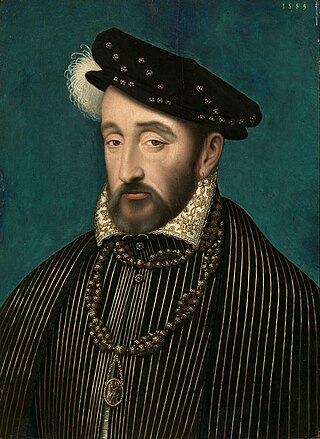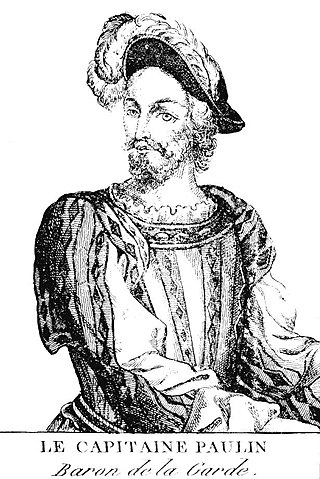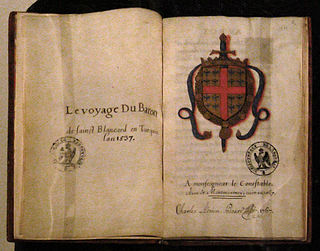
Henry II was King of France from 1547 until his death in 1559. The second son of Francis I and Duchess Claude of Brittany, he became Dauphin of France upon the death of his elder brother Francis in 1536.

Charles Gravier, comte de Vergennes was a French statesman and diplomat. He served as Foreign Minister from 1774 to 1787 during the reign of Louis XVI, notably during the American War of Independence.

François Baron de Tott was an aristocrat and a French military officer of Slovak origin. Born on August 17, 1733, in Chamigny, a village in northern France, the descendant of a Hungarian nobleman, who had emigrated to the Ottoman Empire and then moved on to France with the cavalry of Count Miklós Bercsényi, and was later raised to the rank of baron.

The conquest of Tunis occurred in 1535 when the Habsburg Emperor Charles V and his allies wrestled the city away from the control of the Ottoman Empire.

The Franco-Ottoman alliance, also known as the Franco-Turkish alliance, was an alliance established in 1536 between Francis I, King of France and Suleiman I of the Ottoman Empire. The strategic and sometimes tactical alliance was one of the longest-lasting and most important foreign alliances of France, and was particularly influential during the Italian Wars. The Franco-Ottoman military alliance reached its peak with the Invasion of Corsica of 1553 during the reign of Henry II of France.

Antoine Escalin des Aimars, also known as Captain Polin or Captain Paulin, later Baron de La Garde, was French ambassador to the Ottoman Empire from 1541 to 1547, and "Général des Galères" from 1544.

Bertrand d'Ornesan, also Bertrand d'Ornezan, Baron de Saint-Blancard, was a French admiral in the service of King Francis I of France. He was general of the galleys of the Mediterranean.

Jean de La Forêt, also Jean de La Forest or Jehan de la Forest, was the first official French Ambassador to the Ottoman Empire, serving from 1534 to 1537. Antonio Rincon had preceded him as an envoy to the Ottoman Empire from 1530 to 1533. When Jean de La Forêt died in Constantinople in 1537, he was succeeded by Antonio Rincon as official Ambassador.

Antonio Rincon, also Antoine de Rincon, was a Spanish-born diplomat in the service of France. An influential envoy from the King of France to Sultan Suleiman I of the Ottoman Empire, he made various missions to Constantinople between 1530 and 1541. While an effective diplomat, Rincon's enemies considered him a renegade and some later observers would criticize him for promoting Machiavellian policies.

The Invasion of Corsica of 1553 occurred when French, Ottoman, and Corsican exile forces combined to capture the island of Corsica from the Republic of Genoa.

A Habsburg–Persian alliance, Habsburg-Safavid alliance or Habsburg-Iran alliance was attempted and to a certain extent achieved in the 16th century between the Habsburg Empire and Safavid Iran in their common conflict against the Ottoman Empire.

An Ottoman embassy to France was sent in 1533 by Hayreddin Barbarossa, the Ottoman Governor of Algiers, vassal of the Ottoman Emperor Suleiman the Magnificent.

Janus Bey, in Turkish Yunus Bey was a Greek who became an interpreter (dragoman) and ambassador for the Ottoman Empire.

An Ottoman embassy to France occurred in 1534, with the objective to prepare and coordinate Franco-Ottoman offensives for the next year, 1535. The embassy closely followed a first Ottoman embassy to France in 1533, as well as the Conquest of Tunis by Hayreddin Barbarossa on 16 August 1534, which marked a strong reinforcement of Ottoman positions in the Western Mediterranean.

A Franco-Hungarian alliance was formed in October 1528 between King Francis I of France and King John Zápolya of Hungary.

The siege of Corfu in 1537 was led by the Ottoman Emperor Suleiman the Magnificent, against the Republic of Venice-held island of Corfu. It is part of the Ottoman–Venetian War (1537–1540), one of the numerous Ottoman–Venetian Wars of the period.
André de Montalembert (1483–1553), Seigneur d'Essé, was a French nobleman and officer of the 16th century. As a young boy he fought in the Italian Wars. He was chosen by Francis I as one of his three brothers-in-arms in 1520 at the Field of the Cloth of Gold tournaments with Henry VIII of England.

Jérôme Maurand was a 16th-century French priest of Antibes, who accompanied the French officer Captain Polin in conjunction with the Ottoman fleet of Barbarossa in 1544, as a part of the Franco-Ottoman alliance.

La Réale was a French Royal galley of the 16th century.

The Ottoman wintering in Toulon occurred during the winter of 1543–44, following the Franco-Ottoman Siege of Nice, as part of the combined operations under the Franco-Ottoman alliance. It involved the fleet commanded by Ottoman admiral Hayreddin Barbarossa.



















